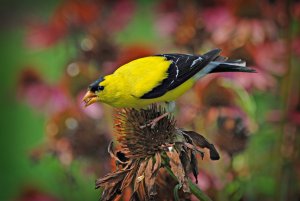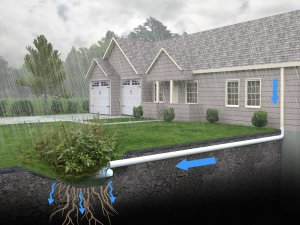Wild Wednesday: Fall-Planted Native Plants Have Many Benefits
November 9, 2022 Erin Parker, Interpretive Services Supervisor
While autumn’s cooling temperatures and impending killing frosts make most gardeners think of all the clean-up they need to do before winter sets in, fall is actually a great time to do some planting, too. Michigan native plants, those that are adapted to the climate and seasons of a region, often require winter’s cold temperatures to thrive. Fall planted seed and plants give gardeners a head-start on spring!
Benefits of native plants
Many of the benefits of native plants are well known. Wildflowers feed pollinators and then provide fruit and seeds to birds and mammals. Native grasses, vines, shrubs, and trees attract native insects which are a critical part of wildlife food webs. Regionally adapted plants and animals are dependent on the timing of blooming, hatching, and migration arrival in spring and fall so that hungry birds arrive to coincide with peak food abundance, and other animals start fueling up for winter hibernation or spring emergence at the same time as their food sources are readily available.

Along with wildlife value, native plants also play a role in managing stormwater and erosion. Replacing the traditional mowed lawn, composed of grasses with shallow root systems, can increase water retention in the soil, reduce flooding events, and slow the flow of stormwater across a landscape. Think of the deep and extensive root systems of prairie and meadow plants as a sort of sponge that absorbs water from rain, snowmelt, and runoff from streets and parking areas. Water is then stored in the soil and within the tissues of the plants themselves which also functions to filter sediments and pollutants from that water.
These same extensive root systems can reduce erosion as they form a net that helps keep soil in place and the leaves and plant material above the soil slows water movement from precipitation and runoff. Slow-moving water doesn’t have the same ability to carve out or carry away soil or sand, helping to keep them in place.

Fall planting
Plants native to the Great Lakes region, including southeast Michigan, often need a winter stratification period. This means they need to experience cold temperatures for a period of time before they break dormancy. Planting in the fall, before the ground fully freezes over, can give these plants time to settle into their new space before winter arrives. Then, cold and snow can work their seasonal magic!
Woody plants, like trees and shrubs, and herbaceous plant starts should be well-watered for a few weeks after planting so that their roots can get established before the ground freezes. Many perennial seeds can be sown now or through the winter, even on top of the snow, as long as they get a few weeks of cold.
Winter Sowing
If autumn gets away from you before you’ve gotten your seeds in the ground, another way to get a jump-start on your native plant garden is simply planting the seeds during mid-winter. Winter sowing of perennials is popular for a reason- it scratches the mid-winter itch to plant and gives seeds the cold period they need. Winter sowing is also simple. Between late December and early February, gardeners can use re-cycled plastic containers such as those for yogurt or even milk jugs. Poke drainage holes in the bottom or slice off the top of the milk jug and fill ¾ full with potting soil. Thickly plant your native species of choice and set outside. Let them have exposure to snow, ice, rain, and melting. In early spring, tiny green sprouts should be visible (if planted in milk jugs, make sure to monitor on sunny days so that they don’t cook!) Keep the plants watered during the summer. By fall, winter-sown seeds can be planted as small starts for much less than purchasing the plants individually.
Increasing the native plants in our backyards benefit wildlife and humans. They typically require much less water, fertilizer, mowing, and even maintenance as compared to a traditional lawn once they are established. Add a few native plants to your landscape this fall and reap the benefits of reduced stormwater and increased habitat.
